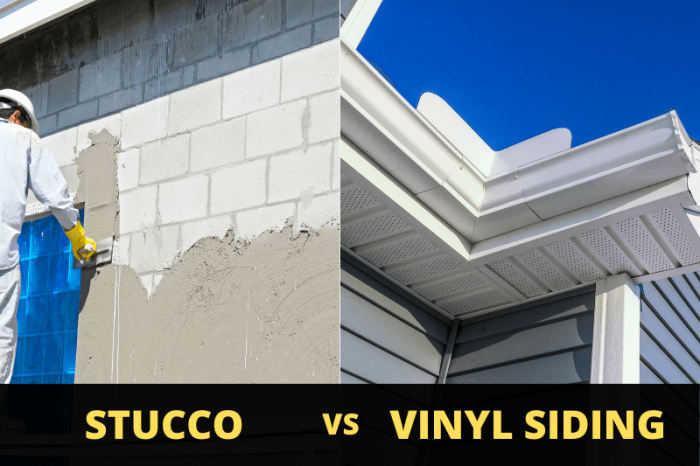Kicking off with Siding vs Stucco: Which Exterior is Right for You?, this opening paragraph is designed to captivate and engage the readers, providing an informative overview of the comparison between these two exterior materials.
Exploring the history, importance, and key aspects of siding and stucco, this discussion aims to help you make an informed decision for your home's exterior.
Introduction
Siding and stucco are two popular choices for exterior materials in construction projects. Siding refers to the protective material attached to the exterior of a building, typically made of vinyl, wood, or fiber cement. On the other hand, stucco is a cement-based material that is spread over a wire framework to create a durable and weather-resistant finish.
Both siding and stucco have been used for centuries in construction, with siding dating back to the early colonial period in America and stucco having roots in ancient Greece and Rome. The choice between siding and stucco ultimately depends on factors such as climate, budget, and aesthetic preferences.
Importance of Exterior Materials in Construction
Choosing the right exterior material is crucial for the overall durability and appearance of a building. Siding and stucco not only provide protection against the elements but also contribute to the aesthetic appeal of a structure. The decision between siding and stucco can impact the maintenance requirements, energy efficiency, and overall value of a property.
Siding
When it comes to the exterior of your home, choosing the right siding material is crucial for both aesthetic appeal and functionality. Let's explore the different types of siding materials, their durability, maintenance requirements, and popular color and texture choices.
Types of Siding Materials
- Vinyl: Known for its affordability, versatility, and low maintenance.
- Wood: Offers a natural and timeless look but requires more maintenance to prevent rot and insect damage.
- Fiber Cement: Durable, fire-resistant, and available in a variety of styles to mimic wood or stucco.
Durability of Siding Materials
- Vinyl: Resistant to rot, moisture, and insects, but may fade over time.
- Wood: Susceptible to rot, insect damage, and warping if not properly maintained.
- Fiber Cement: Highly durable, resistant to fire, moisture, and pests, with minimal maintenance required.
Maintenance Requirements
- Vinyl: Requires periodic cleaning to prevent mold and mildew buildup.
- Wood: Needs regular painting or staining, as well as sealing to protect against the elements.
- Fiber Cement: Low maintenance, only needing occasional cleaning to maintain its appearance.
Popular Siding Color and Texture Choices
- Color: Neutral tones like gray, beige, and white are popular choices for a timeless and versatile look.
- Texture: Options include smooth finishes for a modern aesthetic, or textured finishes to mimic the look of wood or stone.
Stucco
Stucco is a popular exterior finish made of cement, sand, lime, and water. It is applied in multiple layers to create a durable and attractive surface for buildings.
Composition of Stucco Material
Stucco is composed of a mixture of cement, sand, lime, and water. The exact ratio of these ingredients can vary depending on the desired texture and strength of the stucco finish.
Application Process of Stucco on Buildings
The application of stucco involves multiple steps. First, a wire mesh is attached to the exterior walls to provide a surface for the stucco to adhere to. Then, the stucco mixture is applied in several layers, with each layer allowed to dry before the next one is added.
Finally, the stucco is finished with a texture or color coat to achieve the desired look.
Benefits of Stucco as an Exterior Finish
Durability
Stucco is a long-lasting material that can withstand harsh weather conditions.
Low Maintenance
Stucco requires minimal maintenance and can be easily cleaned with water.
Fire Resistance
Stucco is resistant to fire, making it a safe choice for exterior finishes.
Versatility
Stucco can be applied in various textures and colors to suit different architectural styles.
Common Issues or Drawbacks Associated with Stucco
Cracking
Stucco may develop cracks over time due to settling or shifting of the building.
Moisture Absorption
Stucco can absorb moisture, leading to mold or mildew growth if not properly maintained.
Repairs
Repairing damaged stucco can be challenging and may require professional assistance.
Cost
The initial cost of stucco installation can be higher compared to other exterior finishes.
Cost and Installation
When it comes to choosing between siding and stucco for your home exterior, cost and installation are important factors to consider. Let's compare the cost of siding versus stucco installation and delve into the installation process for each option.
Cost of Siding vs Stucco Installation
- Siding installation costs can vary depending on the material chosen, with vinyl siding being more affordable compared to fiber cement or wood.
- Stucco installation tends to be more expensive upfront due to the labor-intensive application process and specialized skills required.
- Additional factors such as the size of the project, location, and contractor fees can also impact the overall cost of siding or stucco installation.
Installation Process of Siding and Stucco
- Siding installation typically involves measuring and cutting the siding material to fit the exterior walls, securing it in place, and finishing with trim pieces.
- Stucco installation requires a multi-step process including applying a base coat, adding a finish coat, and sometimes incorporating texture for visual appeal.
- Both siding and stucco installation processes should be carried out by experienced professionals to ensure proper application and long-lasting results.
Factors Affecting Cost of Siding or Stucco Installation
- The type of material chosen for siding or stucco can significantly impact the overall cost of the project.
- Complex architectural designs or intricate details on the exterior walls may require additional labor and could increase the installation cost.
- Geographic location and local building codes can also influence the cost of siding or stucco installation, as certain areas may have specific requirements or restrictions.
Additional Costs Associated with Siding or Stucco Projects
- For siding projects, additional costs may include insulation installation, trim work, and any necessary repairs to the underlying structure.
- Stucco projects may incur extra expenses for scaffolding rental, moisture barrier installation, and potential repairs to the stucco finish over time.
- It's important to budget for these additional costs upfront to avoid any surprises during the siding or stucco installation process.
Design and Aesthetics
When it comes to the design and aesthetics of a building, the choice between siding and stucco can have a significant impact on the overall look and feel. Both options offer unique characteristics that can complement various architectural styles and enhance curb appeal.
Architectural Styles and Suitability
- For traditional or colonial-style homes, siding such as clapboard or cedar shakes can provide a classic and timeless look.
- Modern and contemporary architecture often pairs well with smooth stucco finishes, offering a sleek and minimalist appearance.
- Craftsman-style homes can benefit from both siding and stucco, depending on the specific design elements and color choices.
Choosing the Right Exterior Material
- Consider the architectural style of your home when choosing between siding and stucco to ensure a cohesive and harmonious look.
- Take into account the color palette of your surroundings and the overall aesthetic you wish to achieve when selecting the exterior material.
- Consult with a design professional or contractor to get expert advice on which option would best complement your home's architecture.
Enhancing Curb Appeal
- Siding can add texture and depth to a building, creating visual interest and enhancing the overall curb appeal.
- Stucco, with its smooth and uniform finish, can give a clean and contemporary appearance that appeals to many homeowners.
- Combining both siding and stucco in strategic areas can create a dynamic and visually appealing exterior design.
Closing Summary

In conclusion, the choice between siding and stucco ultimately depends on various factors like cost, maintenance, and design preferences. By weighing the pros and cons of each, you can determine which option best suits your needs and aesthetic vision for your property.
Frequently Asked Questions
What are the key differences between siding and stucco?
Siding typically consists of individual panels or boards, while stucco is a cement-based material applied in layers over a wire frame.
Which is more cost-effective, siding or stucco?
In general, siding tends to be more affordable upfront, but stucco may offer long-term savings due to its durability and energy efficiency.
Are there any environmental considerations when choosing between siding and stucco?
Siding materials like vinyl can have environmental impacts during production and disposal, while stucco is more eco-friendly as it is made from natural materials like cement and sand.
Can siding or stucco be customized to match specific design preferences?
Both siding and stucco offer a range of color and texture options, allowing homeowners to customize their exterior based on their unique style preferences.














